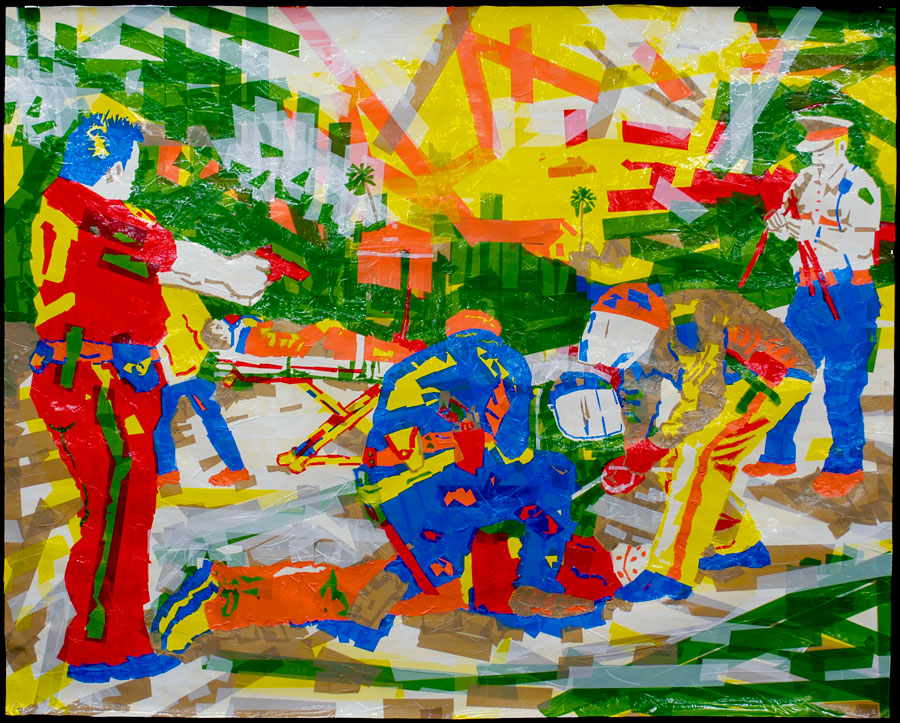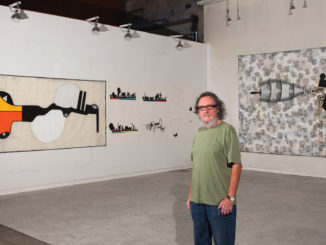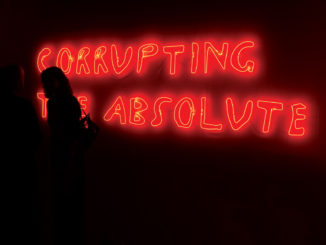Reality TapedKuhl and Leyton have been collaborating for over two years, and have worked closely as artists for over seven years. Kuhl and Leyton’s collaborative works depict crime scenes, emergencies and crisis situations. Their work draws upon mass media’s conventional mode of documenting states of emergency. Police officers, security guards, emergency medical technicians, crime scene investigators, detectives and firefighters are the government forces that arrive to control, organize, and assist with civic disorder. Police officers have long been seen as a symbol of the government. In the movies they have been portrayed as both a hero and a villain; a citizen above the law. In 1989 the reality television program COPS emerged, showing actual footage of police officers on patrol. This television series began a new era for officer’s portrayal in the media. COPS brought police officers into people’s homes and depicted offenders not as criminals, but as stars in a television show. COPS fosters America’s lust for justice. COPS has paved the way for numerous other shows such as Law and Order, ER, and CSI: Crime Scene Investigation. Criminals and crisis situations have become entertainment. They have become stock images for anyone one who even glances at televesion. Katrina, 911, riots by the poor, car chases, take downs – all conjure up the common imagery we all share, that of choas and anger out of control – for whatever reasons. At any given time the same thing could happen to you. The collaborative works of Kuhl and Leyton have been impacted by what COPS initiated. Kuhl and Leyton create the scenes with “found imagery” – however, several sources are often used to produce the final image. The role of the characters and their situations are ambiguous. A man points a gun, medics in the background place a man on a gurney. Who is helping, who is hindering or committing a crime? These scenes are familiar to society and, although not everyone has experienced such a crisis first hand, television has helped a great deal to bridge this gap. The collaborative works of Kuhl and Leyton provide artistic commentary on media, violence, the government and their relationship to each other – and to us, the viewers – the spectators. There work conjures up the experiences we have on television, but there work also provides opportunity to pause and consider the images and feelings evoked in a deeper and perhaps more meaningful manner. For more information, please call: 305.490.6906
Brad Kuhl and Monique Leyton

Kuhl and Leyton have been collaborating for over two years, and have worked closely as artists for over seven years. Kuhl and Leyton’s collaborative works depict crime scenes, emergencies and crisis situations. Their work draws upon mass media’s conventional mode of documenting states of emergency. Police officers, security guards, emergency medical technicians, crime scene investigators, detectives and firefighters are the government forces that arrive to control, organize, and assist with civic disorder.
Police officers have long been seen as a symbol of the government. In the movies they have been portrayed as both a hero and a villain; a citizen above the law. In 1989 the reality television program COPS emerged, showing actual footage of police officers on patrol. This television series began a new era for officer’s portrayal in the media. COPS brought police officers into people’s homes and depicted offenders not as criminals, but as stars in a television show. COPS fosters America’s lust for justice. COPS has paved the way for numerous other shows such as Law and Order, ER, and CSI: Crime Scene Investigation.
Criminals and crisis situations have become entertainment. They have become stock images for anyone one who even glances at televesion. Katrina, 911, riots by the poor, car chases, take downs – all conjure up the common imagery we all share, that of choas and anger out of control – for whatever reasons. At any given time the same thing could happen to you.
The collaborative works of Kuhl and Leyton have been impacted by what COPS initiated. Kuhl and Leyton create the scenes with “found imagery” – however, several sources are often used to produce the final image. The role of the characters and their situations are ambiguous. A man points a gun, medics in the background place a man on a gurney. Who is helping, who is hindering or committing a crime?
These scenes are familiar to society and, although not everyone has experienced such a crisis first hand, television has helped a great deal to bridge this gap. The collaborative works of Kuhl and Leyton provide artistic commentary on media, violence, the government and their relationship to each other – and to us, the viewers – the spectators. There work conjures up the experiences we have on television, but there work also provides opportunity to pause and consider the images and feelings evoked in a deeper and perhaps more meaningful manner.
Carol Jazzar
Scope Miami. Room 202
305.490.6906
www.cjazzart.com
Leave a Reply
You must be logged in to post a comment.



Be the first to comment